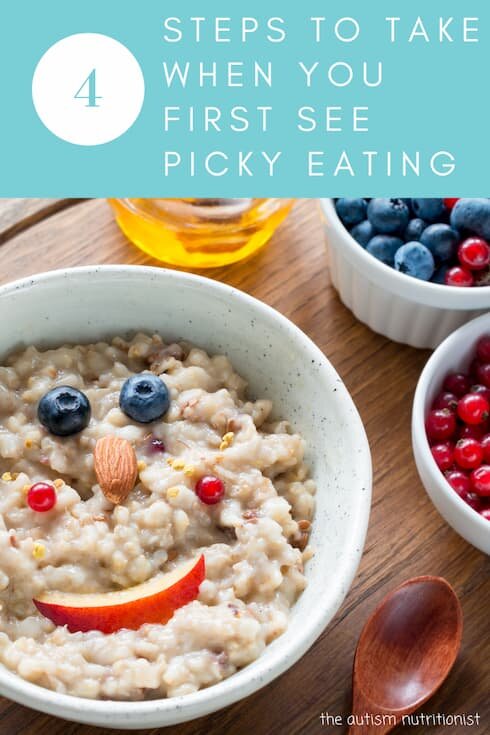
It’s hard to identify extreme picky eating at first. Is it normal and will it go away or is this something more severe? Should you let it play out or begin to seek help? In the beginning it’s impossible to know and often by the time you identify your child’s eating as a problem, it feels too late (I promise you it’s not, though!).
Usually, extreme picky eaters have legitimate underlying reasons for eating – or not eating – what they do. It’s unlikely that your behavior as a parent or caregiver could significantly change that. But, as the ones in charge of deciding the foods that a child has on their plate, we do have an opportunity to help improve a child’s tolerance of non-preferred foods and even encourage more food flexibility. If we encourage these behaviors early on, it can be easier to help kids overcome picky eating later on and it’s even possible that we could interfere with the development of more severe eating behaviors.
I’ve worked with enough families of extreme picky eaters to have identified common pitfalls that parents ultimately wish they had avoided. Read on for tips on how to correct their missteps so you can help your child learn to eat better.
The First Things You Should Do When Picky Eating Starts
- Continue to serve formerly preferred foods – Formerly preferred foods are any foods your child used to eat and has since started rejecting. Think of anything all the way back to first foods up to the foods they most recently started rejecting. You can serve these in small portions the same way they were used to eating them or change up the presentation a little.
- Offer tiny portions of new foods – Small portions are key. You might want to start as small as a penny or even tinier – the size of a grain of rice! Additionally, you can give your child a choice about the foods you’ll serve: which food do you want to work on? Which size bite do you want? Try to only offer two options for them to choose between.
- Expose your child to non-preferred foods, even if it’s just the ones that you’re eating – Don’t isolate your child from non-preferred foods even if they’re uncomfortable being around them. Exposure is crucial for learning to like new foods. If they can’t tolerate a non-preferred food on their plate yet, you can always place them on the table or ensure that they witness you or other family members eating a variety of foods.
- Involve them in food-related activities such as gardening, grocery shopping, and cooking – This goes right there with exposure. The more a child experiences new foods – especially in a way that engages all of their senses – the more comfortable they will be ultimately eating new foods. I love cooking with kids. Grocery shopping and gardening are also effective for creating new food exposures and positive experiences with new foods.
Recap
As a parent, your child’s picky eating isn’t your fault. Still, there are easy steps you can take to help prevent picky eating behaviors from worsening when you first notice them.
Homework
Identify one area where you could improve. Make a plan to change that behavior this week.



0 Comments